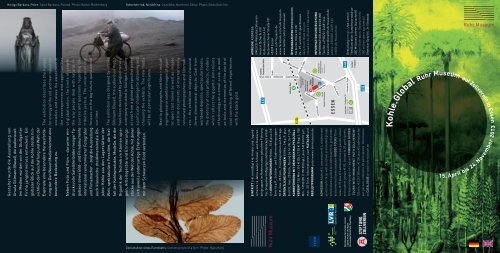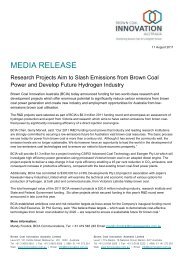Coal Global Exhibition, Essen, Germany 15 April
Coal Global Exhibition, Essen, Germany 15 April
Coal Global Exhibition, Essen, Germany 15 April
Erfolgreiche ePaper selbst erstellen
Machen Sie aus Ihren PDF Publikationen ein blätterbares Flipbook mit unserer einzigartigen Google optimierten e-Paper Software.
Heilige Barbara, Polen Saint Barbara, Poland Photo: Rainer Rothenberg<br />
Kohlefahrrad, Nordchina <strong>Coal</strong> Bike, Northern China Photo: Bodo Goerlich<br />
Gestaltet wurde die Ausstellung von<br />
Ursula Gillmann (Basel), die audiovisu ellen<br />
Medien wurden von der Stuttgarter<br />
Firma jangled nerves entwickelt. Ein<br />
globaler Blick auf die Kohle stellte hinsichtlich<br />
der Beschaffung und Wahl der<br />
Exponate eine beson dere Herausforderung<br />
dar. Den Neuen Medien kommt eine<br />
besondere Bedeutung zu.<br />
Neben Foto und Film – darunter eindrucksvolle<br />
Satellitenbilder riesiger Tagebaue<br />
sowie Bild- und Filmdokumente<br />
international renommierter Fotografen<br />
und Filmemacher – zeigt die Ausstellung<br />
auch klassische dreidimensionale Objekte:<br />
Kohle aus den Lagerstätten der<br />
Welt, spektakuläre Fossilien, die Vielfalt<br />
der Kohleprodukte, Modelle, die die<br />
Gigantik der Technik im Kleinen spiegeln,<br />
Arbeitsgeräte und Erinnerungsstücke<br />
aus der Welt der Kohle, mit denen<br />
sich jeweils andersartige Erfahrungen<br />
mit dem Schwarzen Gold verbinden.<br />
The exhibition describes the hunger<br />
for energy of the old and new industrial<br />
societies and raises the awareness of<br />
the consequences and opportunities<br />
of globalisation, the limits of growth,<br />
the way people deal with natural resources<br />
and questions regarding distributive<br />
justice. The universe of coal<br />
focuses on the big future questions of<br />
our time.<br />
The exhibition was designed by Ursula<br />
Gillmann (Basel), the audiovisual media<br />
have been developed by jangled nerves,<br />
a company situated in Stuttgart. Looking<br />
at coal from a global perspective poses<br />
a particular challenge for obtaining and<br />
choosing the exhibits. The new media<br />
will be of particular significance.<br />
Next to photographs and films – including<br />
impressive satellite images of gigantic<br />
open cast mines as well as images<br />
and film documents of internationally<br />
renowned photographers and filmmakers<br />
– the exhibition displays classical<br />
three dimensional objects: <strong>Coal</strong> from<br />
worldwide deposits, spectacular fossils,<br />
the diversity of coal products, models<br />
which reflect the gigantic dimensions<br />
of technology on a small scale, as well<br />
as tools and mementos of the world of<br />
coal connecting different experiences<br />
with the black gold.<br />
EINTRITT 6 €, ermäßigt 4 €, Kinder und Jugend -<br />
liche bis 14 Jahre sowie Schüler- und Studierenden<br />
grup pen im Rahmen einer gebuchten Führung<br />
frei, Gruppenermäßigungen und Kombitickets erhältlich<br />
GRUPPENFÜHRUNGEN 90 Min., 70 € plus 5 €<br />
Eintritt p.P., Schüler- und Studierendengruppen<br />
50 €, max. 20 Teiln., Fremdsprachen auf Anfrage<br />
ÖFFENTLICHE FÜHRUNGEN 90 Min., 3 € p.P. plus<br />
Eintritt, max. 20 Teiln., Do und Sa 14 Uhr, So 11 Uhr<br />
KOMBIFÜHRUNG MIT DEM DENKMALPFAD ZOLL-<br />
VEREIN ® 120 Min.: 110 € (Dt.) / 120 € (Engl.); 180<br />
Min.: 135 € (Dt.) / <strong>15</strong>0 € (Engl.), plus 5 € Eintritt p.P.,<br />
max. 20 Teiln. Informationen zum KATALOG und<br />
BEGLEITPROGRAMM unter www.ruhrmuseum.de<br />
ADMISSION Adults € 6, concessions € 4, children and<br />
juniors up to 14 as well as school and student groups<br />
who booked a guided tour admission free, group rates<br />
and combined tickets available GUIDED TOURS 90 minutes,<br />
€ 70 plus € 5 admission fee per person, school<br />
and student groups € 50, limited to 20 participants,<br />
foreign languages on request COMBINED GUIDED<br />
TOURS WITH MONUMENT PATH ZOLLVEREIN ®<br />
120 min.: € 120 / 180 min.: € <strong>15</strong>0, plus € 5 admission fee<br />
per person, limited to 20 participants. Information<br />
on CATALOGUE on www.ruhrmuseum.de<br />
A 42<br />
E S S E N<br />
Ausfahrt<br />
Gelsenkirchen Heßler<br />
H<br />
A 40<br />
ADRESSE ADDRESS<br />
UNESCO-Welterbe Zollverein<br />
Areal A [Schacht XII]<br />
Kohlenwäsche [A 14]<br />
Gelsenkirchener Straße 181<br />
45309 <strong>Essen</strong><br />
www.ruhrmuseum.de<br />
www.facebook.com/ruhrmuseum<br />
www.twitter.com/ruhrmuseum<br />
ÖFFNUNGSZEITEN OPENING HOURS<br />
Mo bis So 10 bis 18 Uhr<br />
24., 25. und 31.12. geschlossen<br />
daily from 10 am to 6 pm<br />
closed on 24, 25 and 31 December<br />
INFORMATION UND BUCHUNG<br />
INFORMATION AND BOOKING<br />
Telefon +49(0)201 24681 444<br />
besucherdienst@ruhrmuseum.de<br />
phone +49(0)201 24681 444<br />
info@ruhrmuseum.de<br />
Gestaltung design: Uwe Loesch<br />
Titelillustration: Sumpfmoorwald vor<br />
300 Millionen Jahren (Ausschnitt)<br />
Cover illustration: Swamp forest<br />
300 million years ago (detail)<br />
Stanislav Opluštil, Jiri Svoboda<br />
Fritz-Schupp-Allee<br />
Ernestinenstraße<br />
Frillendorfer Straße<br />
Straße<br />
Schonnebeckhöfe Katernberger Schalker Straße<br />
Gelsenkirchener Straße Gelsenkirchener Straße<br />
B 224<br />
Ückendorfer Straße<br />
Arendahls Wiese<br />
Lierfeldstraße<br />
Straßenbahn 107<br />
Haltestelle Zollverein<br />
Tram 107<br />
Stop Zollverein<br />
<strong>Essen</strong>er Straße<br />
Hauptbahnhof<br />
Main Station<br />
HBF<br />
Straßenbahn 107<br />
Tram 107<br />
H<br />
H<br />
Bus 183<br />
Haltestelle Kohlenwäsche<br />
Zollverein Nord<br />
S<br />
Welterbe Zollverein<br />
Schacht XII<br />
Haltestelle <strong>Essen</strong>er<br />
Stadtrundfahrten<br />
H<br />
A 52<br />
Ruhr<br />
Museum<br />
PA1<br />
Ausfahrt<br />
Frillendorf<br />
Kohle.<strong>Global</strong> Ruhr Museum auf Zollverein in <strong>Essen</strong><br />
<strong>15</strong>. <strong>April</strong> bis 24. November 2013<br />
Zellstruktur eines Farnblatts Cell structure of a fern Photo: Hans Kerp<br />
Netzwerk<br />
Kulturelles<br />
Erbe<br />
Ministerium für Familie, Kinder,<br />
Jugend, Kultur und Sport<br />
des Landes Nordrhein-Westfalen
Bergmann, Türkei <strong>Coal</strong>miner, Turkey Photo: Tahir Özgür<br />
Tagebau, Indonesien Open cut mine, Indonesia Photo: Baudouin Koenig<br />
Bergarbeiterprotest, Spanien <strong>Coal</strong>miner’s protest, 2012, Spain Photo: AFP/Cesar Manso<br />
Auf Zeche Zollverein wird wieder Kohle<br />
gebunkert. Das Ruhr Museum zeigt<br />
„Kohle.<strong>Global</strong>“, die große Ausstellung zu<br />
einem Thema von weltweiter Bedeutung.<br />
Nie zuvor wurde so viel Kohle abgebaut<br />
und verbraucht wie heute. Nahezu jedes<br />
dritte Land der Erde ist Kohleproduzent,<br />
fast alle Staaten sind Kohleverbraucher.<br />
Kohle ist Teil der Weltwirtschaft: Kohle<br />
wird global finanziert, gehandelt und<br />
transportiert.<br />
„Kohle.<strong>Global</strong>“ zeigt die Gegenwart der<br />
Kohle und ihre Entstehung im Zuge der<br />
Erdgeschichte. Die Ausstellung stellt die<br />
pflanzlichen Produzenten der fossilen<br />
Energiequelle und die Produzenten auf<br />
dem Kohle-Weltmarkt, die Wanderung<br />
der Kontinente mit ihren Kohlelagerstätten<br />
und die Transportwege der Kohle aus<br />
den globalen Kohlerevieren zum Verbraucher<br />
vor. Sie zeigt die Speicherung<br />
von CO 2<br />
in der Kohle über Millionen von<br />
Jahren und dessen kurzfristige Freisetzung<br />
durch Verbrennung. Sie visualisiert<br />
die Wälder mit ihren urtümlichen Pflanzen,<br />
aus denen die Kohle entstand, und<br />
die Kohlelandschaften der Gegenwart<br />
mit riesigen Tagebauen, Megastädten<br />
und rauchenden Schornsteinen.<br />
„Kohle.<strong>Global</strong>“ ist eine Weltreise zu den<br />
Kohlerevieren der anderen, von Spitzbergen<br />
bis Feuerland, von Indonesien bis<br />
Südafrika, von Wyoming bis Sibirien. Es<br />
kommt zu faszinierenden Begegnungen<br />
mit verschiedenen „Kohlemenschen“,<br />
die das schwarze Gold fördern, mit ihren<br />
unterschiedlichen Kulturen und mit<br />
der Vielfalt und Ungleichzeitigkeit ihrer<br />
Arbeitswelten; alles mit massiven Folgen<br />
für Mensch und Umwelt – im Guten<br />
wie im Schlechten.<br />
In vielen Kohleländern schafft der Bergbau<br />
eine spürbare Verbesserung der<br />
Lebensbedingungen. Er ist ein Garant<br />
für bessere Infrastrukturen, Fortschritt,<br />
Arbeitsplätze und Wohlstand. Weltweit<br />
wird der Abbau aber auch wegen<br />
des Verbrauchs von Landschaft, der<br />
Verdrängung von Natur und Bevölkerungsgruppen<br />
und der Umweltschäden<br />
durch Emissionen kritisiert. Kohle gilt<br />
als „Klimakiller“. Der Streit zwischen<br />
Anhängern der Kohleindustrie und Umweltschützern<br />
ist dabei immer ein Streit<br />
unterschiedlicher Interessen.<br />
Die Ausstellung beschreibt den Energiehunger<br />
der alten und neuen Industriegesellschaften<br />
und schärft das<br />
Bewusstsein für die Folgen und Chancen<br />
der <strong>Global</strong>isierung, die Grenzen des<br />
Wachstums, den Umgang mit Rohstoffen<br />
und für Fragen der Verteilungsgerechtigkeit.<br />
Im Kohlekosmos geht es um die<br />
großen Zukunftsfragen unserer Zeit.<br />
<strong>Coal</strong> is being stored at Zeche Zollverein<br />
again. The Ruhr Museum presents “<strong>Coal</strong>.<br />
<strong>Global</strong>”, a major exhibition on an issue<br />
of global significance. <strong>Coal</strong> excavating<br />
and consumption has never been as high<br />
as today. Almost every third country in<br />
the world is a coal producer; nearly all<br />
countries are coal consumers. <strong>Coal</strong> is<br />
part of the global economy: <strong>Coal</strong> is financed,<br />
traded and transported on a<br />
global scale.<br />
“<strong>Coal</strong>.<strong>Global</strong>” shows the present of coal<br />
and its formation in the course of the<br />
Earth’s history. The exhibition introduces<br />
the plant-based producers of the fossil<br />
energy source as well as the producers<br />
on the global coal market, the drifting of<br />
the continents with their coal deposits<br />
and the transport routes of the coal from<br />
the global coal fields to the consumer.<br />
The exhibition shows the storage of CO 2<br />
in coal from over millions of years and its<br />
short-term release by burning. It visualises<br />
the forests with their ancient plants<br />
from which coal was formed, and the<br />
present coal landscapes with enormous<br />
open cast mines, megacities and smoking<br />
chimneys.<br />
“<strong>Coal</strong>.<strong>Global</strong>” is a new journey around<br />
the world to the coalfields of the others,<br />
from Spitsbergen to Tierra del Fuego,<br />
from Indonesia to South Africa, from<br />
Wyoming to Siberia. This journey leads<br />
to fascinating encounters with various<br />
“coal people” who produce this black<br />
gold, with their different cultures and<br />
the diversity and difference in the pace<br />
of their daily work life; everything resulting<br />
in severe consequences for humans<br />
and the environment – for good or ill.<br />
In many coal countries mining achieves<br />
an effective improvement of the living<br />
conditions. It is seen as a guarantee of a<br />
better infrastructure, progress, employment<br />
and prosperity. However, the excavation<br />
of coal is also globally criticised<br />
due to the consumption of the landscape,<br />
displacement of nature as well as groups<br />
of people and the damages caused to<br />
the environment by emissions. <strong>Coal</strong> is<br />
considered to be a “climate killer”. The<br />
dispute between supporters of the coal<br />
industry and environmentalists is always<br />
an argument about differing interests.<br />
Schaufelbagger, Mongolei Shovel excavator, Mongolia Photo: SouthGobi Resources Ltd.<br />
Bergmann, Polen <strong>Coal</strong>miner, Poland Photo: REUTERS / Peter Andrews<br />
Moderne Zechenanlage, China Modern colliery, China Photo: Walter Lindner



